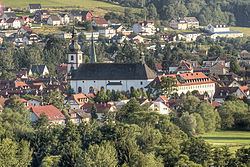Admin. region Darmstadt Time zone CET/CEST (UTC+1/+2) Area 58.62 km² Local time Tuesday 1:08 AM Dialling code 06056 | Postal codes 63628 Population 13,598 (30 Jun 2009) Postal code 63628 Administrative region Darmstadt | |
 | ||
Weather 7°C, Wind SW at 26 km/h, 94% Humidity | ||
Spessart therme bad soden salm nster
Bad Soden-Salmünster is a town in the Main-Kinzig district, in Hesse, Germany. It is situated on the river Kinzig, between Fulda and Hanau. It has a population of around 13,000.
Contents
- Spessart therme bad soden salm nster
- Map of 63628 Bad Soden SalmC3BCnster Germany
- Landpartie nach bad soden salm nster 1999
- Location
- Subdivisions
- Neighbouring communities
- History
- Creation of the current town
- Government
- Notable buildings
- Transportation
- Utilities
- Notable residents
- References
Map of 63628 Bad Soden-Salm%C3%BCnster, Germany
Landpartie nach bad soden salm nster 1999
Location
The municipality is located on both sides of the Kinzig river in the Main-Kinzig district of Hesse. Its territory extends into the hills of the Vogelsberg to the north and into the Spessart to the south.
The two main population centres, Bad Soden and Salmünster, are both situated in the Kinzig valley.
Subdivisions
The Stadt (town) Bad Soden-Salmünster today consists of the following 11 Stadtteile (boroughs): Ahl, Alsberg, Bad Soden, Hausen, Eckardroth, Katholisch-Willenroth, Kerbersdorf, Mernes, Romsthal, Salmünster and Wahlert.
Bad Soden and Salmünster are the two Kernstadtteile (core boroughs). The current municipality was created in the Gebietsreform of 1970, 1972 and 1974.
Neighbouring communities
From the north, clockwise, the neighbouring municipalities are: Birstein, Steinau an der Straße, Gutsbezirk Spessart (an unincorporated area surrounding the Stadtteil of Alfeld), Bad Orb, Wächtersbach and Brachttal. The Stadtteil Mernes is separated from the rest of the municipal territory by the Gutsbezirk Spessart. It also borders on Forst Aura (another unincorporated wooded area and part of the Main-Spessart district of Bavaria) and Jossgrund.
History
Salmünster as a settlement likely dates to the 9th century, but is first mentioned in a document from around 1000, as Salchenmunster. Soden, probably created by Fulda Abbey ca. 909, appears in a document from ca. 1190, referred to as Sodin. Around 152, the abbot of Fulda Abbey had Burg Stolzenberg (see below) erected. Town rights were bestowed in 1296 (Soden, but called Stolzenthal) and 1320 (Salmünster), by King Adolf and Emperor Ludwig, respectively. In 1536, the Huttenschloss (see below) was built.
In medieval times, salt works were an important source of local income at Soden. Since the 12th century the water of the local wells, with a high salt and iron content, was used for salt production. The springs and the village were mortgaged by the abbot of Fulda to the lords of Hutten in 1330, who initially lived at Stolzenfels before moving to a new palace in the mid-16th century. When the Hutten family came into financial difficulties, they in turn mortgaged the area to the Archbishop of Mainz. However, the temporal organization of the Archbishopric, the Erzstift, was already running salt works at nearby (Bad) Orb. To avoid internal competition, salt production at Soden was ended in the later 16th century.
The salt well (Barbarossaquelle) was rediscovered in 1837, and in 1838 Robert Bunsen conducted an analysis of the well's water. In 1872, Soden was granted permission to use the wells for a spa. The first Kurhaus (spa building) was erected in 1889, by which time the region had become a part of the Kingdom of Prussia. Soden has been a Heilbad (spa) and therefore called "Bad Soden" since 1928.
Creation of the current town
The current town was created only on 1 July 1974 when the towns of Salmünster and Bad Soden bei Salmünster merged. During earlier Gebietsreformen, as of 1 December 1970 Wahlert had become a part of Bad Soden. Ahl and Eckardroth followed on 1 April 1972. Alsberg and Hausen were merged with Salmünster on 1 January 1970 followed by Kerbersdorf and Romsthal on 1 December 1970 and Katholisch-Willenroth on 1 July 1972.
Since 1974, the town has been part of the Main-Kinzig district, it was previously part of the Schlüchtern district.
Government
The mayor is Lothar Büttner.
Notable buildings
Transportation
The town has direct access to the Autobahn 66 from Frankfurt to Fulda. It is linked to the rail network by the Bad Soden-Salmünster station (located in the Stadtteil of Salmünster).
Utilities
At Ahl, the Kinzig is dammed by the Kinzigtalsperre, which serves both to control floods and to generate hydroelectric power.
Like in other communities in the area, such as Biebergemünd, Flörsbachtal, Bad Orb and Jossgrund, there is currently controversy over plans to build additional towering wind farms on the wooded peaks. A number of these have already been built in the neighbouring town of Wächtersbach very close to the municipal boundary. Environmentalists and many locals reject these plans due to the destruction of forests and animal habitats, possible health risks to residents, as well as threats to local property values and, in particular, to the tourism business as a result of a declining attractiveness of the region to visitors. It is also questioned whether local winds are strong and constant enough to allow economical operation of the wind farms.
